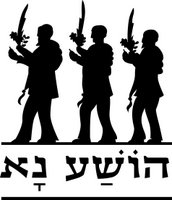
If there is any doubt about the ancient tribal connections of the rituals of Sukkot, the celebration of Hoshana Raba, the last day of Sukkot, should dispell those doubts. If you google Hoshana Raba, you'll find lots of explanations and justifications for the rituals that fall within the sphere of Jewish teachings and practice. For example, look here and here. And I'm glad the rituals from different times have found meanings in different generations--it enhances the spirit of the day.
Hoshana Raba encorporates the rituals of Sukkot week--see the post below for those details--but it's so much more. The service is one of the most, if not the most, complicated of the year. It's kind of a festival morning service, but has some weekday prayers, such as the prayers for thanks, something not said on Shabbat or festivals. The leader really needs to prepare and stay on top of things as we traverse here and there through the prayer book--"page 65....page 204....page 3...." We chant a full Hallel, complete with appropriate shakes and read the Torah--the description of the sacrifices performed at the Temple that week. (see Num 29:12 - 32)
The leader then dons a kittle--the white robe traditionally worn on Yom Kippur--to lead the next part of the service, the Musaf service, using the High Holiday melodies. (One woman remarked this morning--"wow--ceremony complete with costume changes!") Hoshana Raba marks the end of this series of Days of Judgement, one last reminder the keep that teshuvah, that turning and returning of the soul that was felt so deeply, with you as you continue through the year.
And then there's the processionals--not just once around, but 7 times. Each round having it's own theme - our relation to God, our relation to ourselves, our relation to others, our relation to the earth, and so on. This all culminates with the act of taking the willows from the lulav and beating them against the seats until all the leaves are gone. Why? No one really knows, although there are many explanations. Maybe it was a ritual to bring on rain; maybe because though we can make the leaves fall, the branch still exists; maybe it symbolizes the casting off of our sins. All these reasons and more are given. The fact is, no one really knows, and that's the beauty of it. We can connect deeply to our roots and bring our own feelings and interpretation to this powerful moment. For the moment is powerful, you can feel it in the room. We' all let collectively let loose in that moment of frenzy. We are are ready to fill for the next year.
I thank the ancient ones who brought this to us. I once again am able to tap into the stream of past, present, and future generations. As Rabbi Lew taught me, ritual makes the invisible visible. Whatever my doubts about my practice, my questions about my spiritual center--these rituals bring me home.
No comments:
Post a Comment